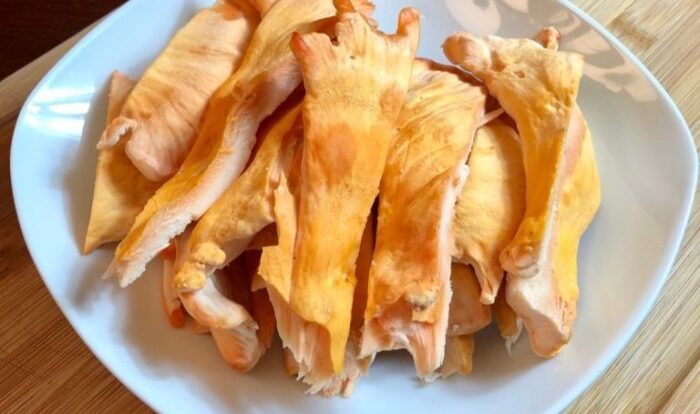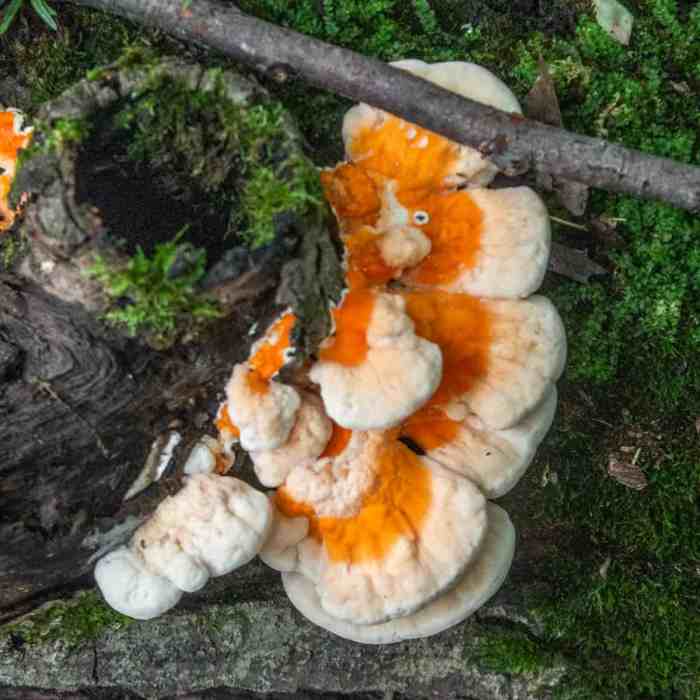
Embark on a culinary adventure with our chicken of the woods recipe, a delectable journey that tantalizes taste buds and inspires culinary creativity. From foraging tips to innovative flavor combinations, this guide unravels the secrets of this woodland delicacy.
Whether you’re a seasoned chef or a novice in the kitchen, our comprehensive guide empowers you to prepare mouthwatering chicken of the woods dishes that will impress your family and friends.
Recipe Variations
Chicken of the woods is a versatile mushroom that can be prepared in a variety of ways. The classic recipe is to simply sauté the mushrooms in butter or oil, but there are many other variations that can add flavor and complexity to the dish.
One popular variation is to add other vegetables to the sauté, such as onions, garlic, or peppers. This adds sweetness and depth of flavor to the dish. Another variation is to add a sauce to the mushrooms, such as a cream sauce or a tomato sauce.
This can help to create a more flavorful and satisfying dish.
Vegetarian or Vegan Adaptations
Chicken of the woods can also be used to make vegetarian or vegan dishes. One popular way to do this is to use the mushrooms as a substitute for chicken in a stir-fry or curry. The mushrooms can also be used to make a vegetarian or vegan “chicken” soup.
These dishes are all hearty and flavorful, and they are a great way to enjoy the unique flavor of chicken of the woods.
Culinary Techniques
Chicken of the woods is a versatile mushroom that can be prepared in a variety of ways, each with its own unique advantages and disadvantages.
Some of the most common culinary techniques used for chicken of the woods include sautéing, roasting, grilling, and frying.
Sautéing
- Sautéing is a quick and easy way to cook chicken of the woods. Simply heat some oil in a pan over medium heat and add the mushrooms.
- Cook the mushrooms until they are browned and tender, about 5-7 minutes.
- Sautéing is a good option if you want to preserve the mushrooms’ natural flavor.
Roasting, Chicken of the woods recipe
- Roasting is another popular way to cook chicken of the woods. Preheat your oven to 400 degrees Fahrenheit.
- Toss the mushrooms with some olive oil and salt and pepper.
- Spread the mushrooms on a baking sheet and roast for 20-25 minutes, or until they are browned and tender.
- Roasting is a good option if you want to caramelize the mushrooms and bring out their sweetness.
Grilling
- Grilling is a great way to cook chicken of the woods if you want to give them a smoky flavor.
- Preheat your grill to medium heat and brush the mushrooms with some olive oil.
- Grill the mushrooms for 5-7 minutes per side, or until they are browned and tender.
- Grilling is a good option if you want to add some extra flavor to the mushrooms.
Frying
- Frying is a delicious way to cook chicken of the woods, but it is also the most unhealthy option.
- Heat some oil in a large skillet over medium heat.
- Dredge the mushrooms in flour and then fry them in the hot oil until they are golden brown and crispy.
- Frying is a good option if you want to create a crispy exterior on the mushrooms.
Flavor Combinations

Chicken of the woods offers a versatile culinary canvas, pairing well with a diverse range of flavors. The key to enhancing its unique taste lies in understanding its inherent characteristics. Chicken of the woods possesses a mild, meaty flavor with hints of nuttiness and a slightly peppery undertone.
These qualities make it an ideal candidate for both bold and subtle flavor combinations.
Herbs
Fresh herbs such as thyme, rosemary, and oregano complement chicken of the woods beautifully. Their aromatic nature enhances the mushroom’s earthy notes while adding a touch of complexity. Thyme’s earthy, slightly minty flavor harmonizes with the mushroom’s umami, while rosemary’s pungent, piney aroma adds a rustic touch.
Oregano, with its slightly bitter and herbaceous notes, provides a refreshing contrast.
Spices
Spices can elevate chicken of the woods to new heights. Cumin, paprika, and turmeric are excellent choices. Cumin’s warm, earthy flavor adds depth and a hint of smokiness. Paprika, with its sweet and slightly smoky undertones, complements the mushroom’s natural sweetness.
Turmeric’s vibrant yellow hue and peppery, slightly bitter flavor provide a unique and flavorful twist.
Sauces
Sauces can transform chicken of the woods into a culinary masterpiece. Creamy sauces, such as béchamel or mushroom cream sauce, create a rich and decadent dish. Tomato-based sauces, like marinara or arrabbiata, provide a tangy and flavorful backdrop. Pesto, with its vibrant green color and aromatic blend of basil, pine nuts, and garlic, adds a fresh and herbaceous touch.
Marinades
Marinating chicken of the woods before cooking infuses it with flavor and tenderizes it. A simple marinade of olive oil, lemon juice, and herbs like thyme and rosemary enhances the mushroom’s natural flavors. For a more robust marinade, try a mixture of soy sauce, honey, and ginger, which imparts a sweet and savory balance.
Nutritional Benefits

Chicken of the woods is an edible mushroom packed with nutritional value. It’s a good source of vitamins, minerals, and antioxidants.
Compared to other edible mushrooms, chicken of the woods is higher in protein and fiber. It also contains more vitamin C and potassium than most other mushrooms.
Antioxidants
Chicken of the woods contains several antioxidants, including ergothioneine, which is a potent antioxidant that may protect cells from damage.
Foraging and Identification: Chicken Of The Woods Recipe

Chicken of the woods is a distinctive mushroom that can be identified by its bright orange color and unique shape. It typically grows in clusters on the sides of trees, particularly oak trees. When foraging for chicken of the woods, it is important to be able to properly identify it to avoid confusion with potentially toxic look-alikes.
One of the key characteristics of chicken of the woods is its bright orange color. The color can range from a pale yellow-orange to a deep reddish-orange, and it is often more vibrant on the edges of the mushroom. The shape of chicken of the woods is also distinctive.
It typically has a shelf-like or fan-shaped appearance, with multiple lobes or segments. The texture of the mushroom is firm and meaty, and it has a slightly velvety surface.
Look-Alikes and Proper Identification
There are several look-alikes of chicken of the woods, including the toxic jack-o’-lantern mushroom ( Omphalotus illudens). The jack-o’-lantern mushroom is also orange in color, but it has a more yellow-orange hue. It also has gills on the underside of the cap, while chicken of the woods has pores.
Another look-alike is the false chicken of the woods ( Hypomyces lactifluorum). The false chicken of the woods is parasitic and grows on other mushrooms. It is typically white or cream-colored, and it has a smooth, slimy surface.
To avoid confusion with look-alikes, it is important to carefully examine the characteristics of the mushroom before consuming it. If you are unsure about the identification of a mushroom, it is best to err on the side of caution and not eat it.
Last Point

As you venture into the world of chicken of the woods, remember that foraging requires caution. Always consult with experienced individuals and use reliable resources to ensure proper identification. With the knowledge and techniques Artikeld in this guide, you’ll be able to savor the unique flavors of this culinary gem with confidence.
FAQ Explained
Can I substitute chicken of the woods with other mushrooms?
Yes, you can use oyster mushrooms, shiitake mushrooms, or portobello mushrooms as alternatives.
How do I clean chicken of the woods?
Use a soft brush to gently remove any dirt or debris. Avoid washing it with water as it can absorb moisture and become soggy.
What are the health benefits of chicken of the woods?
Chicken of the woods is rich in vitamins, minerals, and antioxidants, making it a nutritious addition to your diet.





